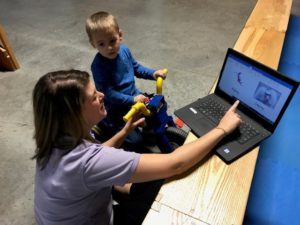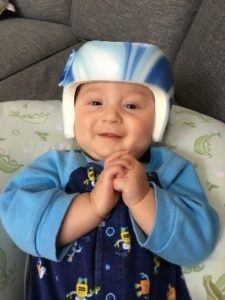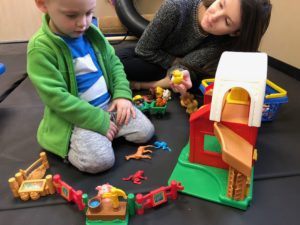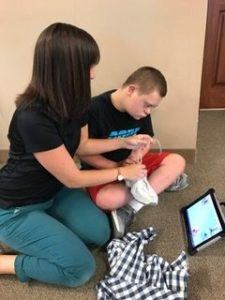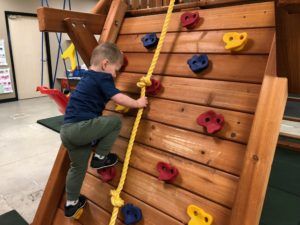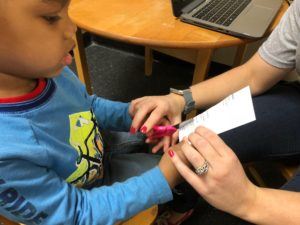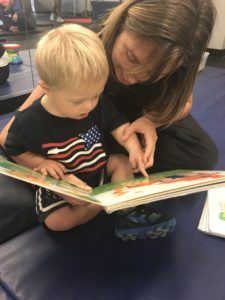Uncategorized
I felt nervous, worried, apprehensive, but mostly curious. I was sitting in the orthotist’s office for her to complete a cranial scan on my son. He was 2 months-old and I was slightly overwhelmed. But I knew we were in good hands because Chris, one of the orthotists at Bioworks, is a professional with whom I have worked closely for over 5 years. And, as a pediatric physical therapist at ABC Pediatric Therapy Network, I was excited to be on the other side of this situation. I have referred several patient’s to Bioworks over the year for the same scan, and now it was my turn to experience it. I was excited to see what happened next.
This all started when my son, Knox, was born 2 months before. He and his twin sister were born just over 3 weeks early and spent time in the NICU. He was there for about 4 days. Once we were home, I started noticing he would typically only turn his head to the left. As a PT, I am always monitoring head position for possible torticollis, or neck tightness, especially in my own children. So, I started repositioning him and performing stretches. Despite this, by the time he was one month-old, I began to notice a flat spot on the left side of his head. I mentioned it to his doctor, who agreed but suggested we continue to monitor it. In the meantime, I continued my work with him at home and began checking with my insurance company on coverage for a cervical orthotisis (helmet).
By age 2 months, my son’s flat spot had gotten worse. He was turning his head more both directions, but continued to have an asymmetrical head shape. His pediatrician and I decided to pursue a helmet. We both knew that the earlier a child begins helmet therapy, the faster and better the results are. This is due to the fact that the baby’s head is growing the most in the first 4-6 months of life. Because of this, I wanted to start using a helmet as soon as possible, instead of waiting for him to possibly improve on his own and missing the best window of treatment in the meantime. This is how I found myself in the orthotist’s office a short time later in the unfamiliar position of patient/parent.
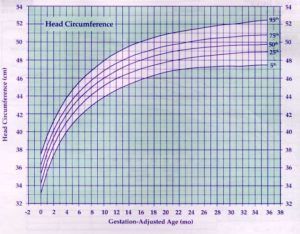
This US Pediatric CDC Growth Chart illustrates the rapid head growth occurring in the first months of life.
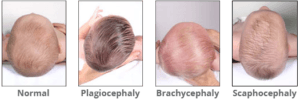
These pictures demonstrate some common head shapes that are often treated with helmet therapy (my son had plagiocephaly)
Picture courtesy of: www.cranialtech.com
The scan indicated a moderate asymmetry (plagiocephaly) and a helmet was recommended. I was happy because I knew we could start treatment early and make great progress. It ended up taking about 2 months to get all the insurance approvals and the helmet made and Knox started wearing his helmet at 4 months-old. Of course, I was concerned about how he would tolerate it, but I shouldn’t have worried. He hardly noticed it at all. He wore the helmet 23 hours a day with removal to bathe him and clean the helmet. He did everything in his helmet, including nursing, rolling over, tummy time… nothing changed or was diminished. The only downside was when he would sometimes get excited and bang his head into my collarbone when I was holding him – ouch!
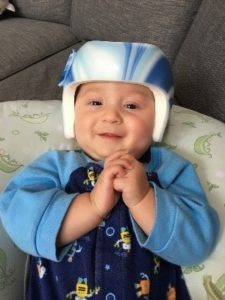
Happy baby in his helmet! He barely even noticed it. he is wearing the Boston Band https://www.bostonoandp.com/products/plagiocephaly/boston-band/
provided by Bioworks www.gobioworks.com
Because of the early intervention, Knox only had to wear his helmet for 2 months. At the time of discharge, he had improved his head shape from a significant asymmetry to only a very slight asymmetry. Now, at age 2, no one could ever tell he had a flat spot at all! I am so happy with the choice I made to pursue a helmet. The minor inconvenience for just 2 short months of his life made such a difference in the long run. I have always recommended to my patients’ families to pursue helmet treatment early if indicated and my own personal experience has solidified this to me.
If you have concerns about your child’s head shape, we can help! Go to http://www.abcpediatrictherapy.com to answer your developmental questions or for info on how to contact us.
Written by: Alyssa Taylor, PT, DPT
Read MoreIf you and others are having a difficulty time understanding what your child is saying and they are demonstrating speech sound errors, your child likely has an articulation or phonological disorder. Don’t let the long names or the word “disorder” intimidate you! These are simply referring to the intelligibility (or clarity) of your child’s speech and can be remediated by a speech-language pathologist. Here is a great chart to follow:
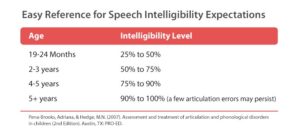
If your child is producing some speech sound errors beyond what is typical for their developmental age, and are considered “mildy” unintelligible, it is likely an articulation disorder.
Articulation Disorder- strategies for home carryover
1) Practice your child’s speech sound being targeted in therapy in a mirror!
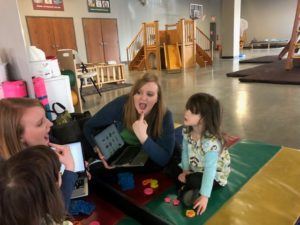
2) Practice your child’s speech sound in a book! This will increase their awareness of the targeted sound. Find books from your local library that have repetitive words with the appropriate speech sounds to target. (For example, if the sound is /g/, try “Go Dog GO!” by P.D. Eastman)
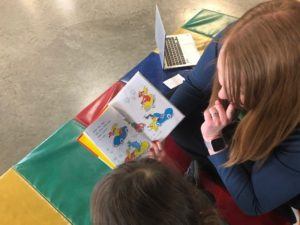
3) Draw attention to your mouth while speaking and use cues to your mouth so that the child can follow your cues for correct speech production on the targeted sounds.
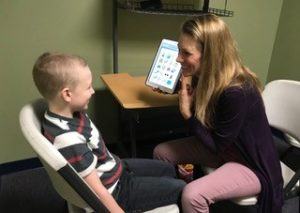
If your child is “highly” unintelligible due to an excessive use of phonological processes that are typical for development, then it is likely a phonological disorder. Please refer to the phonological processes chart from the American-Speech and Hearing Association (ASHA) here: https://www.asha.org/Practice-Portal/Clinical-Topics/Speech-Sound-Disorders-Articulation-and-Phonology/Selected-Phonological-Processes/
Phonological Disorder- strategies for home carryover
1) If your child is deleting final speech sounds in words, make a “snake” down your arm with your pointer finger and “stop” the snake to mark the final speech sound.
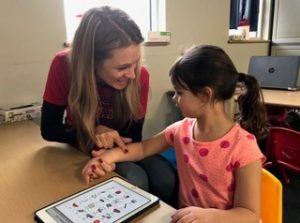
2) To increase awareness of speech sounds, hide your mouth using a small piece of paper and say a targeted word (with the speech sound targeted) correctly and correctly to see if your child can hear the difference and ask them to give you a “thumbs up!” or “thumbs down” to that word with the speech sound. (pic as follows) For example, say “ship” and “sip” if the child is having a difficult time producing the /s/.
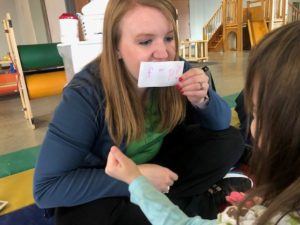
3) Minimal pair practice- using rhyming words that have the initial speech sound being substituted with the appropriate production. For example, if a child is producing the s/z, you would have the child say “sip” and “zip” or “sap” and “zap” so they can feel the difference of productions and increase their awareness of productions and practice the sounds.
At ABC, our ASHA certified and licensed speech-language pathologists can help remediate speech sound errors. Learning through play is crucial to your child’s development and we provide a sensory-enriched experience to allow for kids to target their speech sounds in a fun, play-based approach! Please visit our website https://www.abcpediatrictherapy.com for answers to your questions.
Read MoreWhat is torticollis?
You may have noticed that your baby may prefer to look towards one side, they have difficulty turning their head towards one side, they may keep their head tipped towards a side or maybe they have a flat spot on the back or side of the head. If so, they may have something called torticollis or “wryneck”. Torticollis is tightness of neck musculature that typically causes them to tilt to one side and look towards the other. It can happen before, during, or after birth and can affect their development. It primarily causes the muscles on one side of the body to become tight with the muscles on the opposite side of the body becoming stretched and weakened. This makes it harder to look from side to side, to use their legs and arms normally, and ultimately affect the way they learn to sit, crawl, and play.
Effect on Head Shape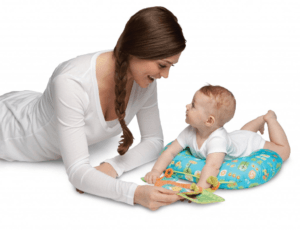
Sometimes prolonged positioning of the baby’s head in one direction cause a flat spot (this is called plagiocephaly). It can affect the shape of the rest of the baby’s head, with changes in the forehead (this is called bossing), changes in ear positioning, and facial asymmetries such as jaw recession. Some babies prefer to be on their backs but do not have a preference for turning their head towards one side, which could lead to the entire back side of the head is flattened (brachycephaly), making the head appear wide. Intervention by a physical therapist, education on positioning and supervised tummy time can help improve the shape of your baby’s head!
Head shape deformity, if not treated early, could lead to the need for a helmet to modify head shape. Helmets are expensive and have to be worn for 23 hours a day. Seek help early to avoid more invasive measures.
Long term effects of head shape not treated could lead to facial deformities. Asymmetry of the eyes could affect the ability of the eyes to work together as well since they will not be in alignment. Glasses would also be a challenge to fit if the eyes and/or ears were not aligned.
Another long term problem could be the ability of a baseball, softball, or football helmet to fit correctly, which can put the child at a higher risk for concussion.
Effect on Development
Tight neck muscles can have a significant effect on child development. 
An infant may have difficulty growing out of reflexes that will effect the baby’s ability to achieve skills. For example, a baby will not be able to feed himself if a reflex called the Asymmetrical Tonic Neck Reflex (ATNR) does not integrate. The baby’s ability to move the head to both sides allows this reflex to mature and go away. Tight neck muscles prevent equal movement to both sides allowing this reflex to remain and effecting the child’s ability to get their hand to their mouth.
Balanced strength on both sides of the body will be limited as the child will choose 1 side of the body over the other to use as the muscles are not tight there.
Tolerance of tummy time will be decreased as control of the head and neck will be effected by tight neck muscles. Strength of the neck, back and arms muscles will decreased if the child does not spend time on his/her belly.
Ability to cross midline or hold bottle in midline is an issue when neck muscles are tight. A child needs to cross midline to dress himself and to perform most skills.
Tight neck muscles may lead to jaw muscle imbalance which effects the seal on a nipple. Imbalances in the jaw can lead to pain in that joint.
Neglect of one side of the body is also seen when a child has Torticollis. The child whole visual field becomes the side of the body in which they see, the side where the tightness occurs, creating more imbalances and delays in motor skills.
Importance of Supervised Tummy Time
After the “Back to Sleep” program was implemented in the 1990’s, there was an increase in torticollis and head shape concerns. The program was successful and the safest place to place your child when asleep and/or unsupervised is on their backs. Many babies spend most of their awake and sleep time on their backs or in equipment such as a bouncer, a swing, a car seat, etc. With more and more time spent in these passive positions, pressure is being placed on one spot of their heads consistently, leading to a flat spot.
Encouraging the baby to look towards the other side from their preferred side will help take the pressure of their flat spot of their heads. One of the best ways to improve the shape of the head while also improving their strength is the use of tummy time while the child is supervised and awake. When a baby spends time in active floor play it encourages motor development, Tummy time especially allows them to build strength in their neck muscles. Supervised tummy time while awake is a very important part of your baby’s development! Eventually they learn how to bear weight through their forearms and extended arms, further building strength in their necks, backs, and arms. By doing so, there is less pressure on their heads and it enforces a more neutral or midline position.
How is this treated?
In many cases, traditional physical therapy can help your baby’s strength, posture, development and head shape. Treatment typically consists of is parent/caregiver education, stretching tight muscles, strengthening weak muscles, and monitoring/addressing developmental gross motor milestones (i.e rolling, crawling, and sitting). Although the physical therapist plays an important role, it is also crucial that the home exercise program be followed as well. This program typically consists of stretches, re-positioning techniques, and strengthening exercises all taught by the physical therapist and usually practiced during the session.
If your baby’s head shape does not respond to repositioning and addressing the torticollis, a cranial shaping helmet may be used to directly address the shape of your baby’s head. The use of the helmet is backed by research and has be proven to be the most effective in terms of returning the head shape towards a more normal appearance. The helmet is worn 23 hours of the day, and is changed periodically by the orthotist as they baby’s head grows.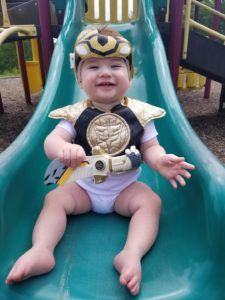
If you have further questions about torticollis, the role of physical therapy, or the use of a helmet, contact an ABC Pediatric Therapy physical therapist for more information and to schedule an appointment. Visit our website at www.abcpediatrictherapy.com to find the nearest location near you.
Read MoreEver wonder what you would write if you could write a letter to your child?
Our children are our most precious gift. What would you say if you were to write a letter to your child?
I know I would want to inspire. I would not tell them they can be anything they want to be. Instead I would teach them to truly inspect. What are you good at? What are you not so good at? Do more of what you are good at. Learn more about what you like. Network with those who do what you want to do. Then go after it. Do not stop until your goals are met.
Teach them that by helping others you help yourself.
Know thyself. Know what you want and what you need and go after it.
Set goals. Don’t just set goals. Strive to reach them. Make it NOT an option NOT to meet them. Break long term goals into several short term goals and go after them all.
Let them know that problems are just barriers to be overcome.
Encourage each to own their mistakes/their problems and learn from them rather than blame others. This will push you to be the leader I know you can be. You will learn to break a problem down into tasks to be completed and soon the problem becomes a solution. Then this child will look at each problem as merely an inconvenience that will be overcome. Each problem will be a barrier that they will remove. My child will be able to minimize the stress in their life as they will be able to solve problems.
I will show them that communication is vital to any successful relationship. In fact, believe it is the reason most relationships fail. Know your wants and needs so you can communicate them to those that are important to you. Then be a good listener. Understand the wants and needs of those important to you and work to meet them. Be flexible as wants and needs can and will change on both sides. That is ok. Just be open to change and be willing to do your best to give those you love what they need.
Above all love. Love in abundance and it will come back to you.
What would you write in the letter to your child?
Read More
Now that Halloween has come and gone, the holiday season is fast approaching. Many family, friends and parents will be wondering what your little preschooler would love to receive! We have compiled a list of fun ideas to have for your little one to unwrap that will also help promote their development.
Gift ideas for preschoolers:
-kinetic sand or sand box with shovel and bucket
-make your own sensory bins: fill containers with beans, rice, water beads, etc and hide holiday items inside for your child to find
-Print your own Christmas songs with movement book such as this one from: https://www.fantasticfunandlearning.com/christmas-songs.html
-cookie/gingerbread decorating kit
-Puzzles
-picture books
-velcro dart board or other target game
-bean bags – great for a variety of games such as a child sized corn hole game or large-scale tic tac toe
-balance beam or balance stepping stones
-blocks –wooden or lego style

-pattern block boards
-wiki stix
-helping hands fine motor tool set
-rhythm instruments: keyboards, xylophone, maracas, tambourines
-large and small balls for kicking, throwing, catching
-tricycle
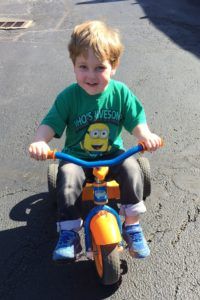
-tunnels
– Plastic bats and balls or bowling set
-art supplies such as non toxic paints, crayons, chalk, stamps, etc.
Feel free to get creative and put a holiday spin on household favorites. For example, if your child loves playdough, you can make your own candy cane dough, put tinsel/sparkles inside of the dough, or make your own slime! There are a variety of recipes available online to suit your needs and your child’s preferences. Feel free to share your ideas with us at: https://www.facebook.com/abcpediatrictherapy/?ref=bookmarks
If you have concerns or questions about your child’s development, please go to our website at https://www.abcpediatrictherapy.com
Read MoreAre you having trouble motivating your child to practice their speech and language skills at home? Your child’s speech therapist is likely assigning tasks to practice at home throughout the week to reinforce the skills they’re learning in therapy. Home practice can make a huge difference in their progress and usually means faster improvement. Speech therapy isn’t an easy fix and it requires a lot of hard work and consistent practice over many months or even years. Home practice does not have to be boring! Below is a list of applications, websites, and games that you can utilize to make home practice fun:
- Applications

o My PlayHome
- Compatibility: iPhone, iPad, and iPod touch
- Price: $3.99
- Description: My PlayHome is an interactive doll house game that contains a variety of male and female characters that can eat, drink, cook, shower, sleep, and so much more. Your child can explore every room in the house while enjoying the colorful and detailed illustrations.
- How to use it:
- Expressive language skills: Labeling actions and common objects, producing regular and irregular past tense verbs, answering wh- questions, describing picture scenes, telling how common objects are used, naming categories, producing he/she pronouns and regular plural -s.
- Receptive language skills: Identifying common items, understanding verbs in context, understanding use of common objects, following directions, and understanding pronouns.
- Why it works: My patients absolutely love this game. It is so fun and motivating- they don’t even realize they are working on a variety of language skills!
o Articulation Station
- Compatibility: iPhone, iPad, and iPod touch
- Price: Lite version is free, individual sounds range from $3.99 to $7.99, and full version is $59.99
- Description: The application includes 22 different sounds and 6 engaging articulation activities to help your child speak and pronounce their sounds more clearly.
- How to use it: Select the individual sound(s) your child is working on in speech therapy and practice at the word, phrase, sentence, or story level.
- Why it works: The application is fun, colorful, and engaging. You can practice your child’s sounds through flashcards, matching games, rotating sentences, unique sentences, and stories. The activities are so fun that my patients often forget they are “working” on their articulation skills.
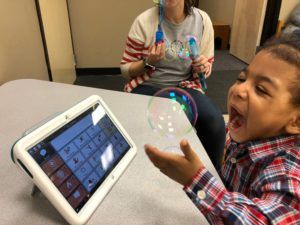
- Websites
o Home Speech Home
- Link: https://www.home-speech-home.com/
- Description: Home Speech Home is a website created by two certified speech-language pathologists. This website offers a variety of activities and word lists to practice articulation, apraxia, language, and stuttering principles. In addition, speech and language developmental norms and an overview of various speech and language disorders are also included.
- How to use it: I frequently utilize the word lists feature with my older patients. I select the specific sound(s) that my patient is working on and incorporate the words while playing their favorite board game or within conversation. You can practice their articulation skills at home with premade words, phrases, sentences, and stories.
o Mommy Speech Therapy
- Link: http://mommyspeechtherapy.com/
- Description: Mommy Speech Therapy is a website created by a certified speech-language pathologist. This website offers a variety of free articulation worksheets that include colorful pictures of your child’s specific target words, as well as helpful tips and tricks on how to increase your child’s speech and language skills at home.
- How to use it: You can select your child’s specific sound(s) and print out the associated free articulation pictures, cut them into individual pictures, and play a variety of games at home. You can hide the pictures around the house and have a “scavenger hunt” and ask your child to name the pictures when they find them. You can print out an extra page and play Go Fish or a matching game with the pictures while reinforcing their articulation skills. The options are limitless!
- Games

o Guess Who
- How to play: You can target a variety of language and articulation skills with this classic board game. Guess Who is great for working on he/she pronouns, asking questions, answering yes/no questions, producing grammatical forms (e.g. do/does, has/have), and articulation skills at the conversational level.
o Hedbanz
- How to play: Hedbanz is a fun way to work on naming categories, answering yes/no questions, turn taking, and articulation skills while your child guesses the identity of the card they’ve been dealt.
o Simon Says
- How to play: Simon Says is a quick and easy game to work on identifying common objects (e.g. body parts), following one-step directions, as well as directions of increasing length and complexity.
If you have questions about your child’s speech and language skills please contact ABC Pediatric Therapy Network at https://www.abcpediatrictherapy.com.
Read MoreEvaluation Step 1: At your first appointment at ABC Pediatric Therapy, you will first meet your therapist in the waiting room. The therapist will bring you back into a small room or an area in the gym to begin your evaluation. Your evaluation will begin with your therapist asking you a few questions about your child such as his/her medical history, birth history, allergies and more.
Most importantly, your therapist will ask you the following question: What are your concerns and goals for your child to achieve by attending physical, occupational, or speech therapy? 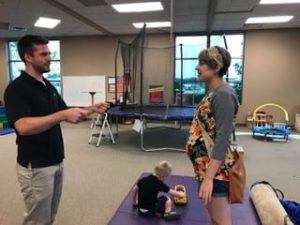
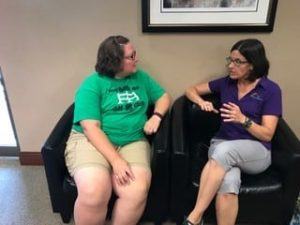
Evaluation Step 2: After providing information about your child, the therapist will assess your child’s strengths and weakness by asking him/her to perform a series of tasks. After assessing your child’s skills, the therapist will determine if your child needs therapy services or if he/she is on track with his/her milestone achievements. If therapy is needed, it will be recommended. For example, your child may be recommended to attend therapy one time per week for a 60-minute session. 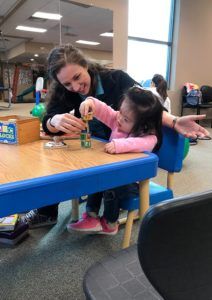
Designing Goals: After a need for therapy is determined, the therapist will write goals to work towards in each therapy session. As a parent, your goals for your child should be reflected in the therapist’s goals for intervention!
Treatment: Treatment begins day one! Treatment may take place in the large gym or a small room depending on the goal targeted and your child’s needs. The therapist will begin to work with your child to improve his/her skills and work toward meeting the goals set. Therapists love having you involved in each treatment session. This is how you learn more about how to help your child. Treatment sessions will continue until your child meets his/her goals set by you and your therapist. The more consistent you are with attending your scheduled appointments, the faster progress will be made. Goals will be updated and changed to challenge your child to progress his/her gross motor, fine motor, or speech skills.
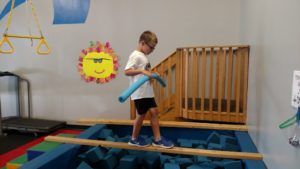
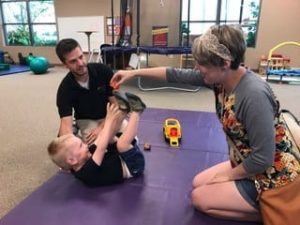
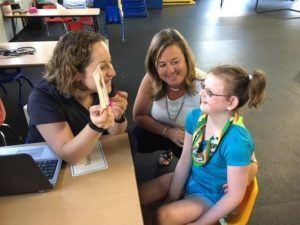
Home Exercise Program: Beginning on your first day, your therapist will provide you with exercises or activities to perform at home for practice. Your therapist will provide guidance on how to practice the tasks to help your child be successful. Ask your therapist for tips on how to practice while keeping up with your busy, daily schedule! Your home exercise program will be updated as your child progresses through therapy.
Discharge: After your child has met the goals set and your child has overcome your concerns, your therapist will recommend discontinuing therapy services. As the parent or guardian, you will be provided with a home program to continue to practice at home. Your therapist will call you periodically to check in. If concerns arise after discharge, you can call back to meet with your therapist. Your therapist is here to help create the best life for all children!
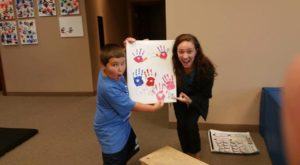
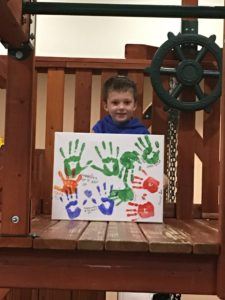
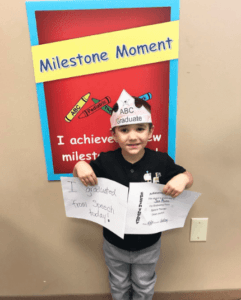
Read More
What is torticollis?
You may have noticed that your baby may prefer to look towards one side, they have difficulty turning their head towards one side, they may keep their head tipped towards a side or maybe they have a flat spot on the back or side of the head. If so, they may have something called torticollis or “wryneck”. Torticollis is tightness of neck musculature that typically causes them to tilt to one side and look towards the other. It can happen before, during, or after birth and can affect their development. It primarily causes the muscles on one side of the body to become tight with the muscles on the opposite side of the body becoming stretched and weakened. This makes it harder to look from side to side, to use their legs and arms normally, and ultimately affect the way they learn to sit, crawl, and play.
Effect on Head Shape
Sometimes prolonged positioning of the baby’s head in one direction cause a flat spot (this is called plagiocephaly). It can affect the shape of the rest of the baby’s head, with changes in the forehead (this is called bossing), changes in ear positioning, and facial asymmetries such as jaw recession. Some babies prefer to be on their backs but do not have a preference for turning their head towards one side, which could lead to the entire back side of the head is flattened (brachycephaly), making the head appear wide. Intervention by a physical therapist, education on positioning and supervised tummy time can help improve the shape of your baby’s head!
Importance of Supervised Tummy Time 
After the “Back to Sleep” program was implemented in the 1990’s, there was an increase in torticollis and head shape concerns. The program was successful and the safest place to place your child when asleep and/or unsupervised is on their backs. Many babies spend most of their awake and sleep time on their backs or in equipment such as a bouncer, a swing, a car seat, etc. With more and more time spent in these passive positions, pressure is being placed on one spot of their heads consistently, leading to a flat spot.
Encouraging the baby to look towards the other side from their preferred side will help take the pressure of their flat spot of their heads. One of the best ways to improve the shape of the head while also improving their strength is the use of tummy time while the child is supervised and awake. When a baby spends time in active floor play it encourages motor development, Tummy time especially allows them to build strength in their neck muscles. Supervised tummy time while awake is a very important part of your baby’s development! Eventually they learn how to bear weight through their forearms and extended arms, further building strength in their necks, backs, and arms. By doing so, there is less pressure on their heads and it enforces a more neutral or midline position.
How is this treated?
In many cases, traditional physical therapy can help your baby’s strength, posture, development and head shape. Treatment typically consists of is parent/caregiver education, stretching tight muscles, strengthening weak muscles, and monitoring/addressing developmental gross motor milestones (i.e rolling, crawling, and sitting). Although the physical therapist plays an important role, it is also crucial that the home exercise program be followed as well. This program typically consists of stretches, re-positioning techniques, and strengthening exercises all taught by the physical therapist and usually practiced during the session.
If your baby’s head shape does not respond to repositioning and addressing the torticollis, a cranial shaping helmet may be used to directly address the shape of your baby’s head. The use of the helmet is backed by research and has be proven to be the most effective in terms of returning the head shape towards a more normal appearance. The helmet is worn 23 hours of the day, and is changed periodically by the orthotist as they baby’s head grows.
If you have further questions about torticollis, the role of physical therapy, or the use of a helmet, contact an ABC Pediatric Therapy physical therapist for more information and to schedule an appointment. Visit our website at www.abcpediatrictherapy.com to find the nearest location near you.
Read MoreIntellectual skills: Provide your child with fun learning games and toys. Reading to them, pointing out things on the pages and asking questions are great ways to build language and increase interest and creativity.
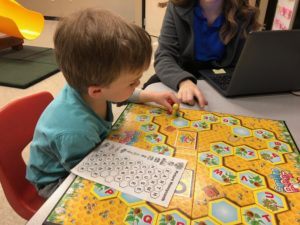
Motivation to learn: Encourage your child to do their best, follow the class rules and show a genuine interest in what they are doing in school. Encourage your child to color, draw, dress themselves and wash their hands. If mom and dad are invested and interested, their kids will want to make their parents proud!
Social skills: Sharing, taking turns, trading toys, waiting turns, eye contact, speaking with an appropriate voice volume and personal space are all skills that will be needed in Kindergarten. As parents, we can guide our children in these skills when we play games and when they play with peers. Community activities provide great opportunities for kids to have fun while building social skills. Craft days at the local craft or hardware store, community sports, the local activity/community center and even a trip to the zoo can all give children experiences to build their social skills.
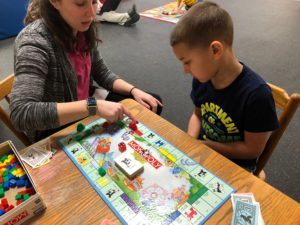
Behavior-management skills: Talk to your child about safety and appropriate behaviors in various settings; how to act on the playground, how to act when an adult is giving directions and how to act when working in a group all require children to use skills that need to be taught ahead of time. Provide time daily for your child to actively play and use their imagination. We can’t expect a child to behave and listen if they don’t have an outlet to play and be a kid. Simple chores can teach your child the value of taking care of things and putting things away; in school they will be expected to do these tasks on a daily basis so it needs to be a skill that is expected at home.
Readiness to learn: Encourage your child to ask questions and help them find the answers! Providing healthy food options, a sense of security, keeping a regular sleep routine, encouraging developmental skills, providing a nurturing home environment, and having parents who show excitement for learning and Kindergarten will get your child ready to learn and lessen anxiety about school!
If you need help getting your child ready for Kindergarten, let us know. We love to help! Go to https://www.abcpediatrictherapy.com for an ABC location near you.
Read MoreHelp your child be comfortable separating from mom and dad: Expose your child to other people early on and consistently. Have grandparents, good friends, babysitters/daycare providers watch your child even for a short time of the day. It’s healthy for babies/toddlers to go through some separation anxiety as this tells you that they recognize mom and dad. However, the exposure to trusting other adults and being comfortable without mom and dad helps your child build confidence and trust in various environments and with and without their parents present.
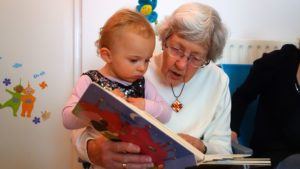
Following another adult’s directions: Teaching your child that they need to listen to you and other adults will help them learn to respect others and will help them to know to listen to their teacher and follow through with assignments as they get older. Following directions will be a big part of their school day; “throw your tissue away, put the crayons in the cup, put your coat on” these will all be frequent directions they will hear and need to follow.
Sitting in a group for Circle Time: In Circle Time, children will be expected to sit, listen to a book, talk about the weather and the day of the week. Parents can prepare their child for this by reading aloud and talking with them about the day so they have practice listening and engaging in conversations.
Working in small groups at Centers: Staying at a Center for 5-10 minutes will take some attention span and working next to their peers will take some parallel play, turn taking and sharing. You can model these behaviors when you play with your child! If you have friends with children about the same age you can set up a play date so they can practice these skills with peers they already know. The more children play, the more creativity and problem solving they will develop.
Being respectful of others: Demonstrating how to treat and talk to others will help your child learn how to be respectful of others and how others should treat them in return.
Learning to get along with peers: Until they are 3 1/2 years old, children will participate in parallel play where they play near each other. Associative play occurs until 4 1/2 when they trade and share toys. At home, you can practice trading, sharing, taking turns with games, pretend play and simple toys.
Learning numbers, counting, letters, recognize their name, shapes, colors: Using books and toys, you can talk to your child about colors, shapes and counting, “Let’s count how many bunnies are on the page!” When playing with toys, talk about the color the toy is, “we’re throwing the red ball!” In the car, listen to the Alphabet Song and songs about counting to make learning fun. Have magnetic letters on the refrigerator, put their name up in their room! When helping your child get dressed, talk about the color shirt/pants they have on, the more you build these facts into their daily vocabulary, the more these skills will come naturally.
Social emotional skills: Talk about feelings, express feelings and demonstrate how to handle frustrations in a healthy way. Setting consistent limits and rules will help kids learn what is expected. Teaching empathy will allow your child to be a good friend to others as well. Recognizing their feelings and guiding them through handling their emotions will minimize meltdowns and help them handle frustrations in a healthy way.
If your child needs help with any of the above skills to be ready for preschool, we want to help! Go to https://www.abcpediatrictherapy.com for more tips on how to help your child.
Read More Skip to content
Skip to content
